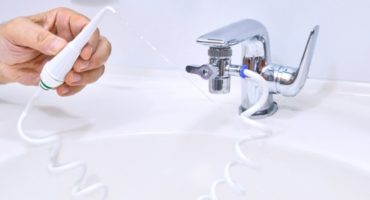Using a toothbrush when caring for the oral cavity cannot bring the highest quality result. For this reason, even if a person brushes his teeth in the morning and in the evening, he will inevitably visit the dentist with certain problems. But with the advent of such a device as an irrigator on the consumer market, the effectiveness of oral care at home can be significantly increased. In this case, it is necessary to understand its main purpose, to know how to use it, and which is better to choose oral irrigator.
What is an irrigator for?
An irrigator is a device whose purpose is to clean the oral cavity. It cannot replace the use of a toothbrush, but will only provide additional care. The principle of operation of the device is to supply a stream of liquid under pressure in a selected direction. Thus, not only the cleaning of teeth from food debris and soft plaque, but also of all interdental spaces, gingival pockets is carried out. At the same time, massage of the gums, the mucous membrane of the mouth and tongue is performed, which leads to the normalization of blood circulation, and therefore, the improvement of the condition of the gums and the teeth themselves.
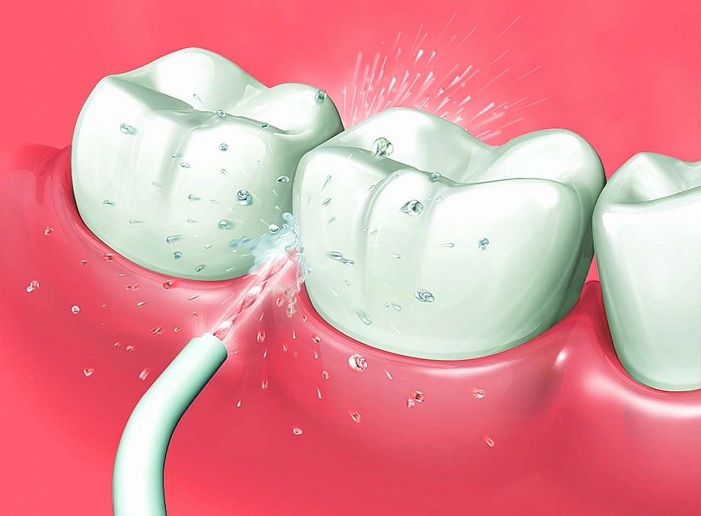
The action of the irrigator is based on the penetration of a stream of liquid into hard-to-reach places
Those who wear fixed prostheses or braces will be able to appreciate the use of an irrigator. It is in this case that food accumulates under them, and cleaning it with a toothbrush is very problematic. Using the device, daily care will be much easier, since a powerful stream of water, getting into the most inaccessible places, washes away all deposits from there.
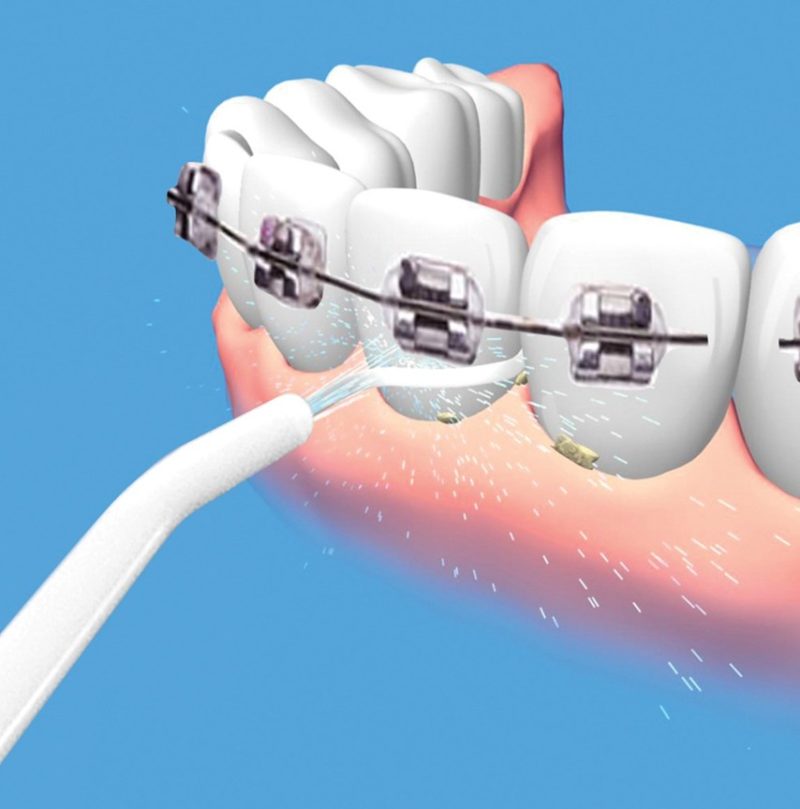
The “carrier” of braces will appreciate the irrigator
There are no contraindications to the use of an irrigator.
At the same time, certain harm can only be done if it is used improperly. If a person suffers from rheumatism, has some abnormalities in the cardiovascular system and in the heart itself, then before using it, it is necessary to consult a doctor. You may also need to stop using the irrigator or reduce the time and number of procedures in the acute stage of periodontitis.
The device is used for:
- prevention of caries, especially if the main place of its formation is the lateral surface;
- oral care in the treatment of occlusion using braces;
- prevention and treatment of gum disease;
- treatment of halitosis - halitosis;
- care for fixed orthodontic structures - implants, crowns and bridges.
The opinion of specialists will help to express a comparative analysis based on the results of clinical studies, during which it was found that regular use of an irrigator reduces the likelihood of bacterial plaque on the teeth and mucous membrane by 24%, increases the effectiveness of brushing by 50%, especially for hard-to-reach ones places In addition, the use of the device reduces the likelihood of caries by 26%, and the effect of water supplied under pressure is more effective than the use of dental floss by 93%.
How the irrigator works
The design of the irrigator includes a liquid tank, a hydraulic pump, a handle and removable nozzles.
When the device is turned on, the compressor begins to supply liquid from the tank under a certain pressure to the handle, from where it goes out through the nozzle. A special regulator is located on the device’s body, which allows you to choose one of the types of fluid supply for operation, namely spraying, pulsating or constant.
In most cases, the kit includes up to five different nozzles - their number and name depends on the model selected. The main types of such nozzles are:
- standard, which is a long metal tube with a tapering bent end. This design allows you to get to the most inaccessible places to ensure flushing and massage;
- periodontal, differing from standard nozzles by the presence on the narrow end of a soft silicone or rubber tip, designed to protect weakened gums from possible touch;
- orthodontic, which is a product that combines the properties of a toothbrush and an irrigator, that is, bristles for mechanical impact and openings for fluid exit. With its help, you can not only easily penetrate into the interdental space, but also clear the gingival margin from plaque. It is convenient for care of bracket systems;
- for implants, which differs from the orthodontic only in that the bristles are not evenly arranged, but are grouped into two or three separate beams located along the circumference of the nozzle nozzle;
- for the tongue - it is a tube for supplying fluid with a spatula, which can quickly and efficiently clean the mucosa from plaque.
Also, a toothbrush is included with most modern irrigators. Such a complete set of the device makes it even more multifunctional, since in this case the device can provide complete oral care.
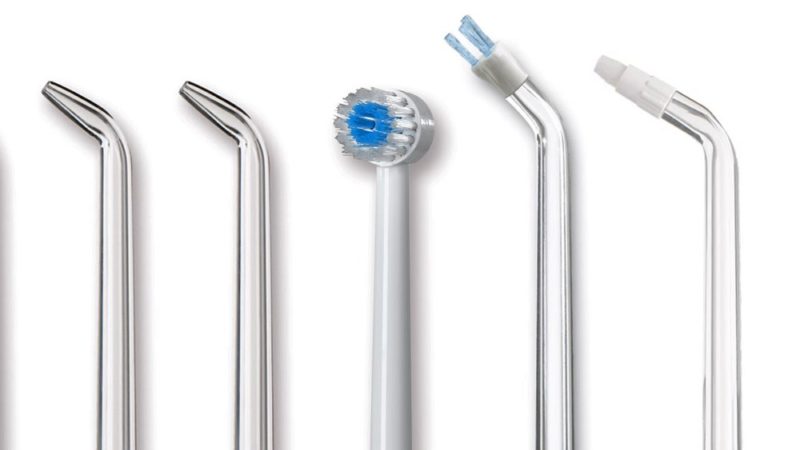
Irrigator nozzles
In addition to nozzles, when using an irrigator, a correctly selected spray mode is very important. So, a constant supply is most appropriate if necessary to clean the cervical region of the tooth, interdental space, as well as other hard-to-reach places. Spray is suitable for massage of the gums and oral cavity. In addition, the form of the jet applicable to the device, which can be:
- continuous, that is, providing a constant flow of fluid;
- pulsating, in which the liquid comes out of the nozzle with microblows that most effectively remove plaque and food debris;
- bubble, in which the liquid is mixed with air bubbles, which leads to its saturation with oxygen.
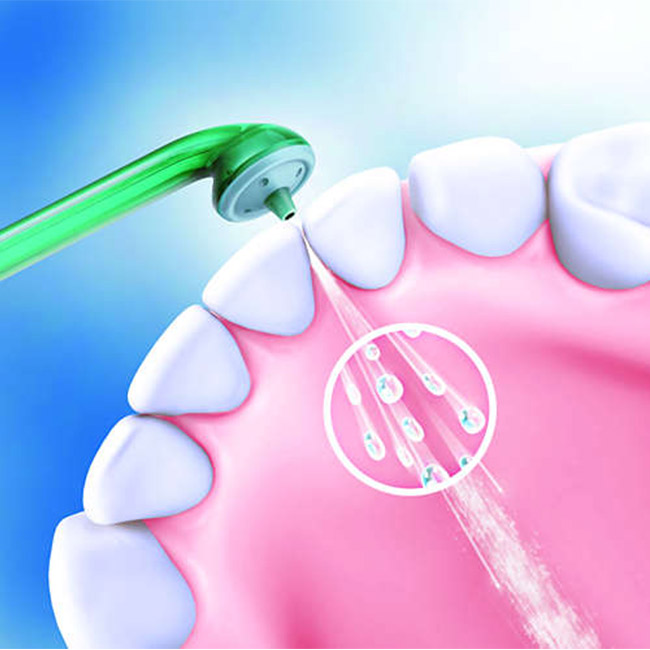
Microbubble technology in the irrigator
Types of Irrigators
All irrigators can be divided into two main types: stationary and portable. Stationary are connected to the mains. Their main advantages include high power, a wide range of working pressure, which can be adjusted independently, as well as a convenient design that allows you to keep the device clean.
Portable irrigators often run on batteries, less commonly on conventional batteries. Their advantages are light weight, size and independence from the current source, which allows you to use the device in any convenient place. At the same time, the power and pressure range in such devices are slightly less.
Both the first and second types of devices are distinguished by the volume of the liquid tank. In portable irrigators, it is usually not enough to perform a complete cleaning of the mouth.
A separate type of stationary irrigators are devices that are directly connected to the water supply. Such devices, although they provide no need to control the liquid level during use, but at the same time only tap water can be used for the procedure, the sanitary state of which is not always good.In particular, such devices are not recommended for the treatment of gum disease, since untreated water can enter the wound, which will lead to inflammation.

Stationary water-powered irrigator
How to use an irrigator
Before you start using the irrigator, you should consult your dentist. Depending on the condition of the teeth and gums, as well as the presence of any orthodontic elements in the mouth, the doctor will choose the optimal mode of use. To use the irrigator to bring maximum effect, you must adhere to certain rules:
- apply the irrigator only after brushing your teeth;
- the fluid used during the procedure should be warm;
- the direction of the stream should be perpendicular to the surface of the gums. That is why all nozzles for the irrigator have a bent end;
- the duration of one procedure should be at least five minutes. With other recommendations of the dentist, it can be increased up to 20 minutes;
- the maximum amount of time should be devoted to cleaning up inaccessible places;
- the position of the head during the procedure should be such that the fluid can flow freely from the mouth. It is not recommended to swallow the water used for cleaning, and even more so the medical solution.
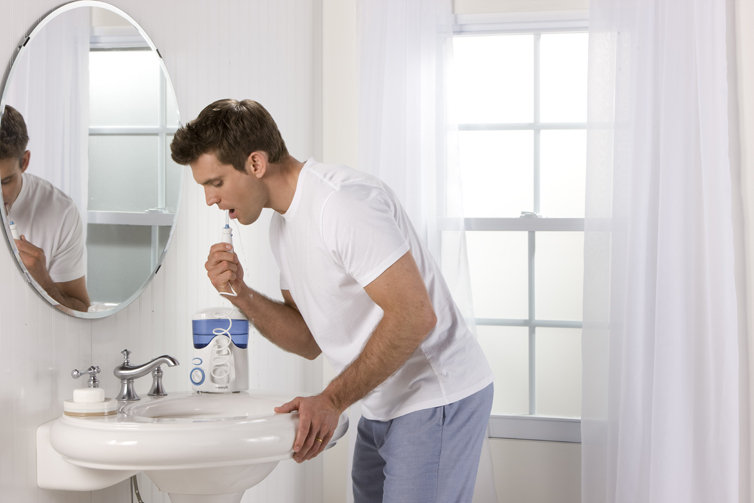
During use of the irrigator, the fluid should be free to drain into the sink
As a liquid for an irrigator, you can use ordinary purified water, but for greater effectiveness, as well as for the prevention and treatment of gum diseases, it is better to use special anti-inflammatory solutions based on medicinal herbs. Only in this case can the destruction of pathogenic microflora be achieved, which is the source of dental caries, unpleasant odors and periodontal diseases. At the same time, it is necessary to select the composition in accordance with the recommendations that the operation manual for the device contains in detail, since improper use of it can lead to breakage.

Irrigator fluid
What to pay special attention to when choosing an irrigator
When choosing an irrigator, first of all, it is necessary to be guided by the extent to which and why it is needed. So, stationary models have a large power - from 600 to 800 kPa. It should be borne in mind that if children and older people use the irrigator, the use of high power is contraindicated. For this case, stationary devices have a special controller that allows each family member to choose an acceptable mode of operation.
Portable irrigators, the average power of which is 500-600 kPa, in most cases do not allow changing the pressure of the fluid supply, which means that the circle of its users will be much narrower.
The set of stationary device most often includes a larger number of nozzles, which today is a small problem, since a suitable product name can be purchased separately.
Portable devices have a smaller number of nozzles, but at the same time provide the ability to use the device up to seven times without a direct connection to the network. This allows you to take the device on vacation or business trip. This is especially necessary in the treatment of gum disease, when interruptions are contraindicated.
The best models of irrigators
- Waterpik WP-100 is a stationary irrigator, costing about 6500 rubles. There are seven nozzles in the kit, including a toothbrush. The choice of pressure when supplying liquid in a microbubble form is regulated at ten levels. Advantages - silent operation and compactness, disadvantages - limited lifetime, with simultaneous use by several family members, which is equal to one and a half years;
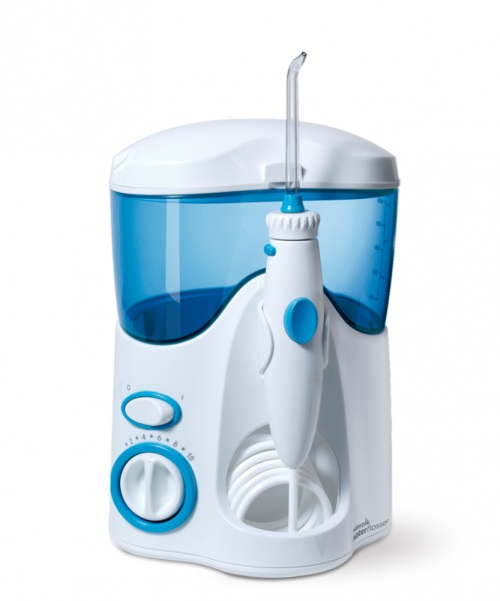
Waterpik WP-100
- Philips AirFloss Ultra - portable or road irrigator costing about 7,600 rubles with micro bubble technology, three spray modes.A full battery charge lasts for almost two weeks of use by one person, while the need for recharging can be determined by the indicator on the case. The disadvantage of this device can only be called the availability of a single standard nozzle;

Philips AirFloss Ultra
- SoWash Family - a stationary irrigator with eight nozzles, working directly from the water supply, costing about 5,000 rubles. For use, you can apply one of two more suitable modes. Among the advantages can be distinguished noiselessness, compactness and ease of use. Of the disadvantages is a slight pressure when supplying fluid.
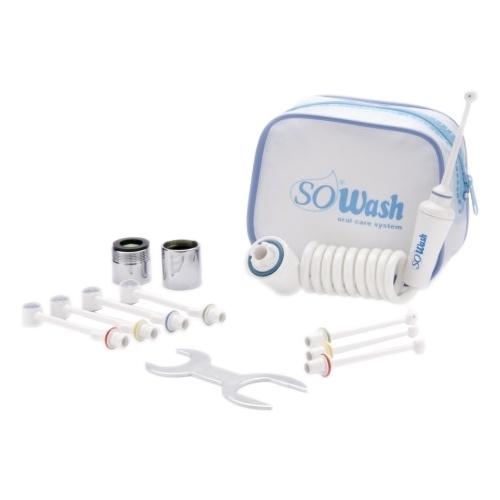
SoWash Family



